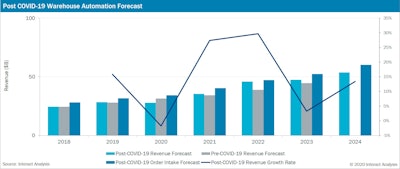
Interact Analysis has produced a newly updated report on the warehouse automation market. The over-riding message is that while scores of industrial sectors have suffered major downturns during the pandemic, and will struggle to recover, the warehouse automation sector is set to see a period of exponential growth. COVID-19 has given a massive and lasting boost to the online-shopping sector, driving warehouse managers to increasingly resort to automation solutions to improve efficiency and productivity, and enable social distancing on the shop floor.
COVID-19 will depress revenues for 2020 as project completion dates are pushed back to 2021. At the same time, however, the sudden uptick in online shopping caused by the virus has resulted in a significant increase in order-intake. Dematic’s second quarter order intake for 2020 was 100% up on the same quarter for 2019, and the company plans to hire 1,000 new staff by the end of 2020. Additionally, the market size of the warehouse automation sector in 2023 is set to be 6% larger than pre-pandemic forecasts. Whilst some sub-sectors, such as manufacturing and apparel, are expected to see a reduction in market share – a combined decrease in value of $600m – general merchandise and groceries will drive a significant overall net increase in the warehouse automation market. The report’s data points to a 2023 combined market value of these two sectors of some $3.5bn higher than pre-COVID forecasts. Ocado is set to become one of the leading warehouse automation-providers in the grocery industry, with contracts to build 38 automated warehouses by the end of 2025.
An additional important finding is that software revenues are under threat as online retailers are increasingly following a growing trend of bringing warehouse execution and management software in-house. Amazon, Alibaba and JD.com have led the way in this respect, and other online retailers plan to follow suit. This could ultimately lead to a level of commoditization of warehouse automation hardware sales, with multiple system integrators forced to bid tendered out solution designs. The research shows that the reason for this is the lack of flexibility from off-the-shelf-software.
Rueben Scriven, lead analyst on warehouse automation at Interact Analysis says: “The warehouse automation world is on the move. COVID-19 has devastated high streets and shopping malls, but there are already signs that eCommerce retailers are preparing to step in, with grocery retailers taking advantage of disused sites to augment micro-fulfilment centers onto existing stores, bringing the fulfilment process closer to the customer, and attracting customers and jobs back in to the high street. When it comes to the issue of automation software development moving in-house, we found that only the grocery sector will likely continue to heavily rely on existing integrator software solutions. The way forward for warehouse automation vendors supplying online retailers is to increase their ability to tailor their software offering to individual customers.



















